1 Nara Park and Tōdai-ji Temple
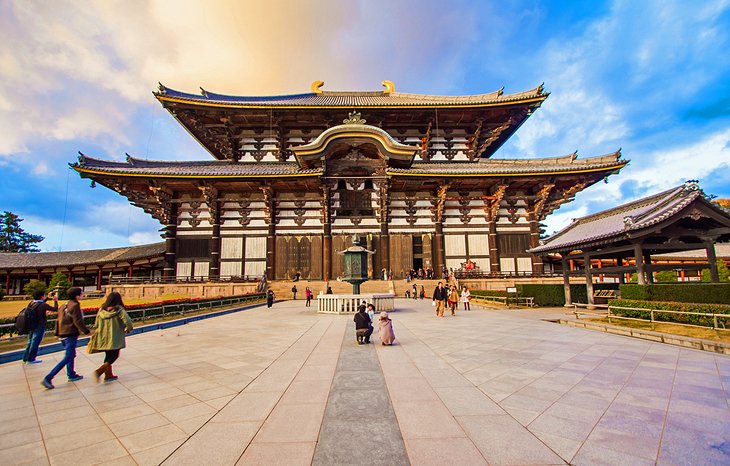
Nara Park and Tōdai-ji Temple
In the heart of the city, Nara Park is home to history, culture, and nature. Highlights include watching the park's roe deer wander the woods and lawns while visiting its many historical buildings, including the magnificent Kofuku-ji Temple adjacent to the large Sarusawa Pond, as well as the Uneme Shrine. The largest such park in Japan(and one of the oldest, having been established in the 1300s), the Nara Park is home to the eighth-century-AD Todai-ji (Great East Temple), the most famous of the Seven Great Temples of Nara. Other Todai-ji Temple highlights include its huge bronze statue of the Great Buddha (Daibutsu), cast in Nara in AD 749; its Great South Gate (Nandaimon), a two-story structure borne on 18 columns with its two Nio statues standing eight meters tall and guarding the temple entrance; and the Hall of the Great Buddha (Daibutsuden), the world's largest timber building and home to the Great Buddha (Daibutsu). In addition to its many other historically significant buildings, the site also boasts beautiful gardens and water features, including ponds, bridges, and pagodas.
Address: 406-1 Zoshicho, Nara, Nara Prefecture 630-8211
2 Kofuku-ji Temple
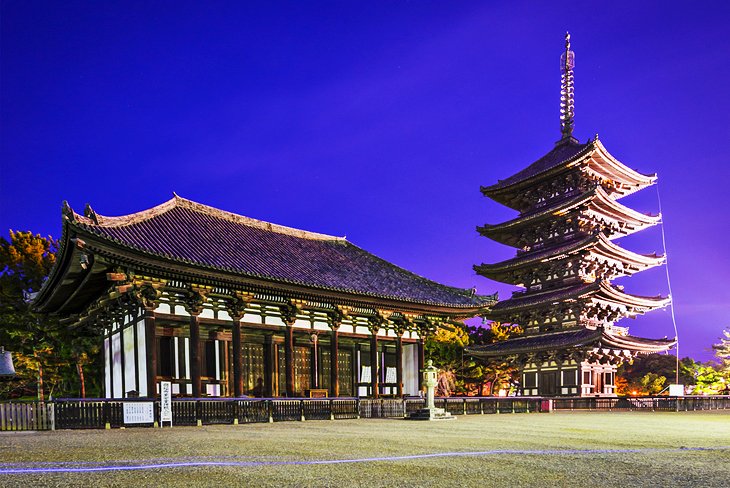
Kofuku-ji Temple
Another of the Seven Great Temples of Nara also in Nara Park, the Kofuku-ji Temple complex consisted of 175 buildings in its heyday. Founded in AD 669, the surviving buildings include an octagonal hall, the Nan-endo, built in AD 813 and home to a statue of Fukukenjaku-Kannon carved in 1188, along with very fine statues of the four celestial guardians and the six patriarchs of the Hosso sect. In front of the hall is a ninth-century bronze lantern with an inscription attributed to Kobo-daishi, as well as a three-story pagoda. Other buildings of note are the Northern Hall (Hoku-endo), also octagonal and built for Empress Gensho in AD 721 and famous for its 13th-century wooden statue of Miroku-bosatsu; the East Hall (To-kondo) with its 15th-century statue of Yakushi-nyorai, along with older eighth-century statues; and a splendid five-story pagoda erected in AD 730, at 50 meters the second highest pagoda in Japan containing many historically significant statues.
Address: Noboriojicho, Nara, Nara Prefecture 630-8213
Official site: www.kohfukuji.com/english.html
3 Isuien Garden
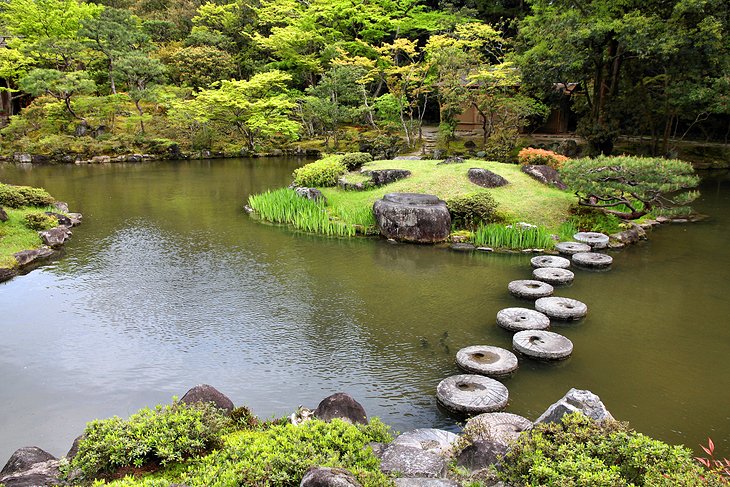
Isuien Garden
The Isuien Garden, home to the small yet interesting Neiraku Art Museum, opened in 1969 and is landscaped in the famous Japanese Shakkei style - literally translated as the "borrowed landscape" - in which the surroundings of the garden are incorporated in the total effect. Together with the museum, it makes for a fabulous outing, especially if you visit the two teahouses in the nearer part of the garden, the Seishuan and the Sanshutei (be sure to also visit the Teishuken waiting room). The older rear part of the garden, laid out in 1899, has the South Gate of the Todaiji and Mount Wakakusa as its backdrop, and on its island in the little lake is a stone from the foundations of the Buddha Hall, while the stepping-stones are old millstones used in the manufacture of fabric dyes. Hot Tip: If you're a tea drinker, be sure to visit the site's other teahouse, the thatched Hyoshintei, for its excellent green tea.
Address: 74 Suimoncho, Nara, Nara Prefecture 630-8208
4 Tōshōdai-ji Temple
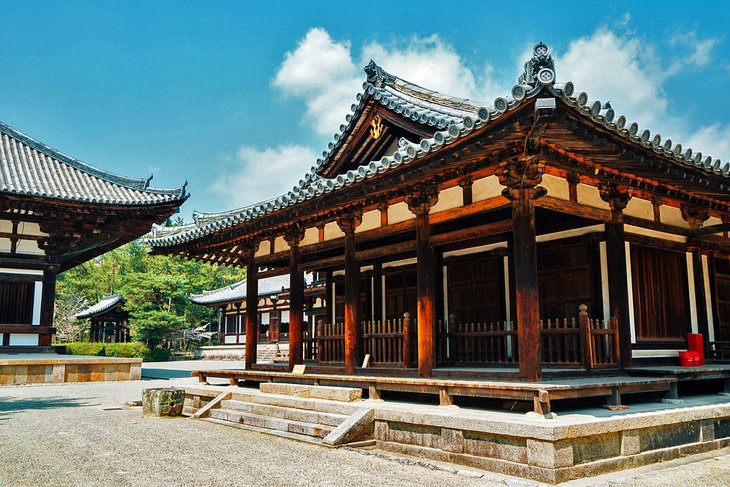
Tōshōdai-ji Temple
Founded in AD 759, Tōshōdai-ji was constructed as the principal temple of the 30 temples of the Ritsu sect. While only two of the original buildings have survived - the Main Hall and Lecture Hall - the site has retained much of its original layout and is a delight to explore. The Main Hall (Kondo), the largest and finest example of Tempyo architecture to have survived in Japan, is famous for its vast pillared gallery and large seated statue of Rushana-butsu and its magnificent halo decorated with 864 small Buddhas. The Lecture Hall (Kodo) is also worth exploring and contains many fine sculptures, including a number carved from a single piece of cypress wood. Other buildings of note are the Priests' Quarters (Higashimuro), the Cult Hall (Raido), and the Drum Tower (Koro), where the Uchiwa-maki festival is celebrated each May.
Address: 13-46 Gojocho, Nara, Nara Prefecture 630-8032
5 Yakushi-ji Temple
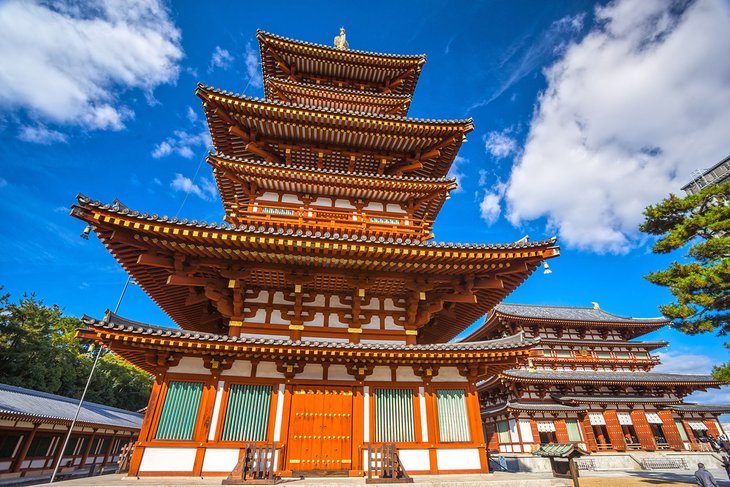
Yakushi-ji Temple
The principal temple of the Hosso sect, Yakushi-ji was originally constructed in the seventh century and still contains statues from that period. Begun in AD 680 during the reign of Emperor Temmu, only the East Pagoda survives, with the remaining structures seen here today dating from the 12th and 13th centuries. Highlights include the Main Hall (Kondo) containing the famous Akushi Trinity, a nearly three-meter-tall figure with both Chinese and Indian influences flanked by noblemen and dating from AD 697. The original three-story East Pagoda, standing 38 meters high and topped by a unique metal pinnacle, is the only surviving example of Buddhist architecture of the seventh century. Behind the pagoda is the East Hall, built in 1285 and containing a two-meter-high bronze figure of Sho-Kannon, a gift from the King of Paekche (Korea). Other buildings of note are the Bussokudo with its stone bearing a footprint of Buddha; the bell tower with a Korean bell; and the treasury containing two fine paintings of Kichijo-ten, goddess of beauty, and a Chinese priest.
6 Kasuga-taisha Shrine
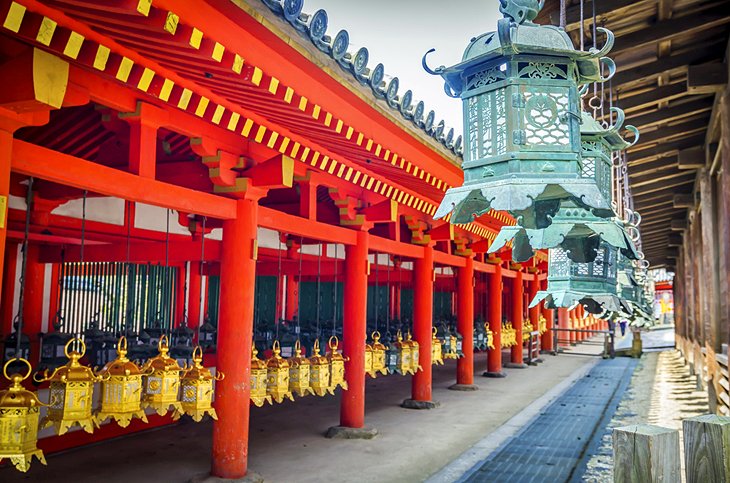
Kasuga-taisha Shrine
The Kasuga Shrine, founded by Fujiwara Nagate during the eighth century, consists of four separate buildings dedicated to the divinities Takemikazuchi and Futsunushi, along with the ancestral gods of the Fujiwara family, Amenokoyane and his consort Hime-okami. The buildings of this UNESCO World Heritage Site are characteristic examples of the Kasuga-zukuri style, differing from early timber buildings in its brightly painted red beams, the white facing of the walls, and the curving roofline. Until 1863, the buildings were pulled down every 20 years and re-erected in their original form, as is still the practice at the Ise Shrines; nowadays, this process of renewal is confined to the roofs. In Deer Park, deer roam freely and are believed to be sacred messengers of the Shinto gods that inhabit the shrine and surrounding mountainous terrain. Also of interest is the adjacent Kasugayama Primeval Forest, a stunningly beautiful reserve, untouched since the ninth century, that is known for its rare birds, trees, and wildlife.
Address: 160 Kasuganocho, Nara, Nara Prefecture 630-8212
Official site: www.kasugataisha.or.jp/guidance/main_sanctuary.html
7 Nara National Museum
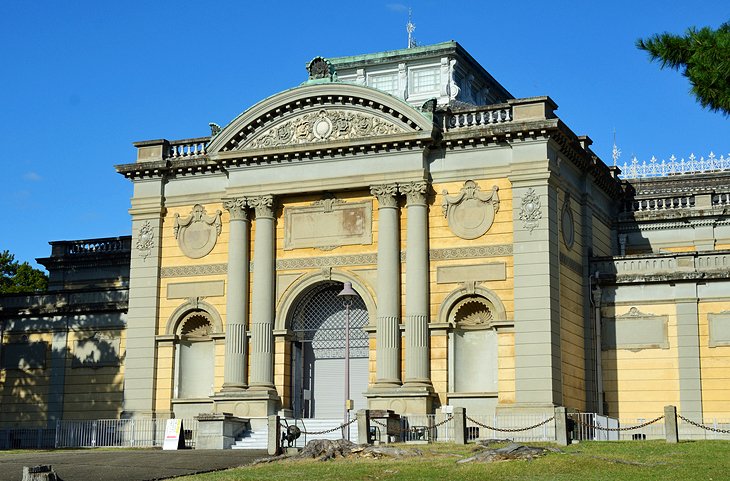
Nara National Museum
Built in 1895, the National Museum is the city's most important museum and houses numerous major works of art, particularly of the Nara period of the eighth century. In addition to periodic temporary displays of exhibits selected from the museum's large reserves, its permanent collection includes a number of galleries dedicated to archaeological finds as well as fine displays of sculpture, paintings, and calligraphy. Of particular interest for those who have visited the city's many fine temples are its collections of important religious items, including numerous Buddhist statues and paintings. English language guides are available.
Address: 50 Noboriōji-chō, Nara, Nara Prefecture 630-8213
Official site: www.narahaku.go.jp/english/index_e.html
8 Hōryū-ji Temple
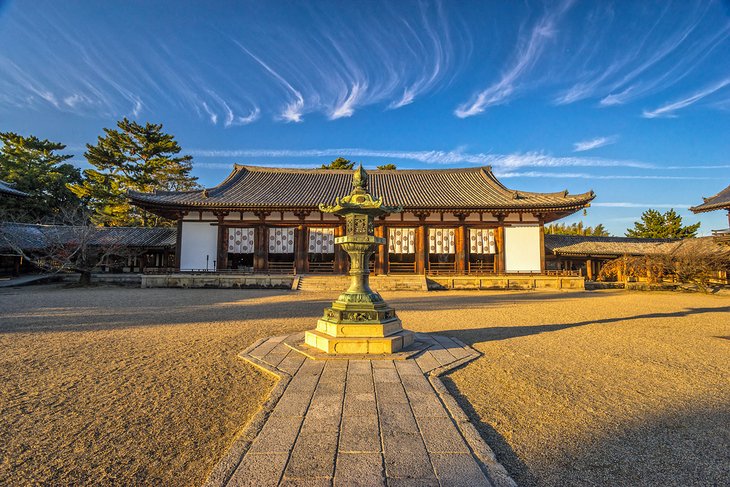
Hōryū-ji Temple
The oldest completely preserved temple complex in Japan, Hōryū-ji is a magnificent example of the architecture of the Asuka period from AD 552-645 with masterly works of art covering the whole range of Japanese history. Built in AD 607 as one of the Seven Great Temples of Nara, Hōryū-ji became the great center of Buddhism in Japan, from which the new faith was carried across the country (in those days the road from the Imperial Court to the coast passed the temple site). The principal temple of the Shotoku sect, the site comprises 45 buildings, 17 of which are classified as Major National Treasures. Divided into two parts - the To-in or Higashi-no-in (the eastern part) with 14 buildings, and the Sai-in or Nishi-no-in (the western part) with 31 buildings - it can take the best part of a day to explore. Particular highlights include the Great South Gate (Nandaimon), from which a path leads to the Middle Gate (Chumon) with its roofed corridors and two guardian figures representing light and darkness dating from AD 711. The spectacular Main Hall (Kondo), a two-story wooden structure, is said to be the oldest surviving wooden building in the world.
Address: 1-1 Horyuji Sannai, Ikaruga, Ikoma District, Nara Prefecture 636-0115
Official site: www.horyuji.or.jp/horyuji_e.htm
MAP
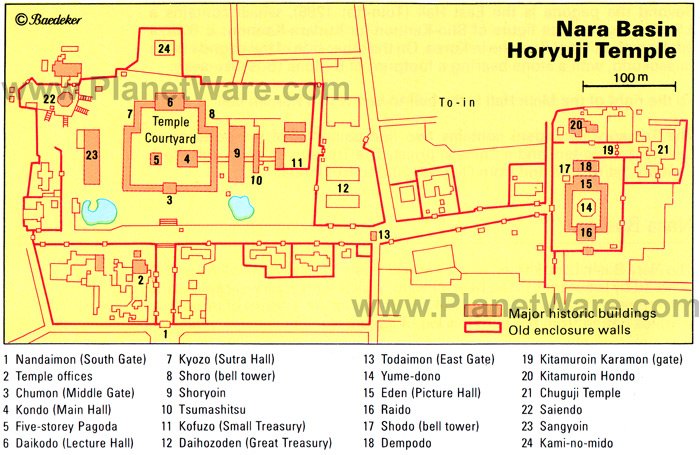
Nara Basin - Horyuji Temple Map
9 Shin-Yakushi-ji Temple
9 Shin-Yakushi-ji Temple
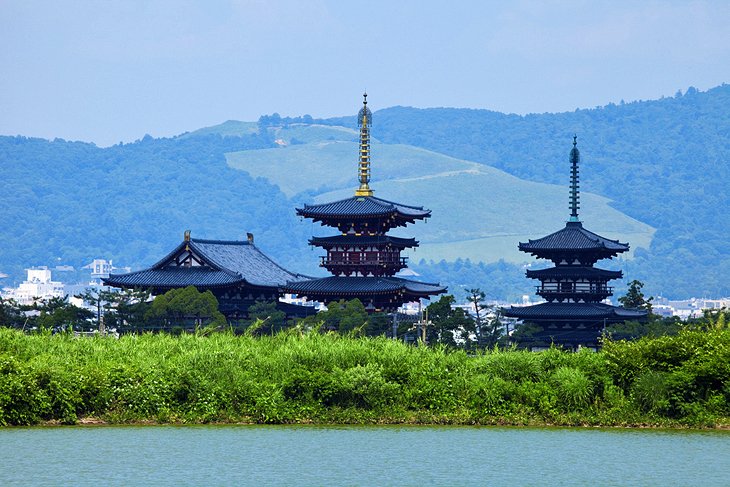
Shin-Yakushi-ji Temple
Founded by the Empress Komyo in AD 747 to secure the help of the gods in curing an eye complaint from which her husband Shomu suffered, the Shin-Yakushiji Temple is a classic example of the Late Nara style. Taking its name from the Healing Buddha (Yakushi) to whom it's dedicated, this important religious site contains a large statue of Yakushi-nyorai carved from a single piece of wood, along with a statue of the Eleven-Headed Kannon surrounded by 12 pottery figures of guardian divinities (Juni-shinsho), all masterpieces of Late Nara sculpture. Also of note is the Main Hall (Hondo), the only part of the original temple to have survived from the Nara period.
Address: 1352 Takabatakecho, Nara, Nara Prefecture 630-8301
10 The Manyo Botanical Garden
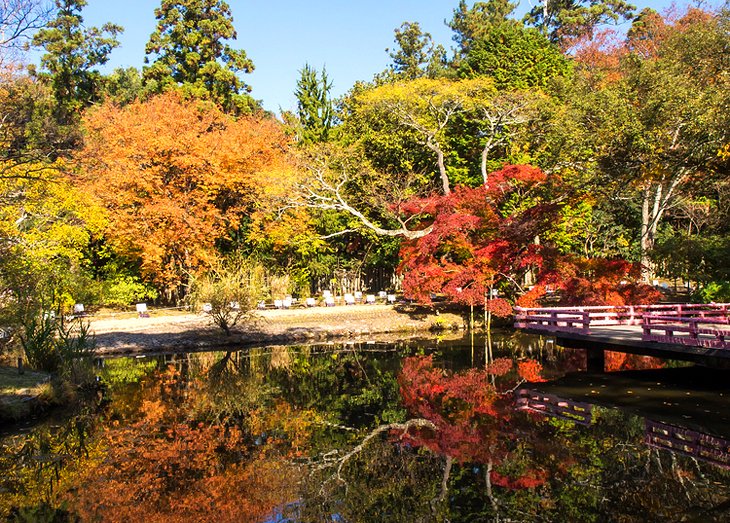
The Manyo Botanical Garden
Boasting more than 150 different varieties of flowering plants and famous across Japan for its inclusion in the ancient Manyo-shu collection of poems, the lovely Manyo Botanical Garden - also often referred to as Kasuga Taisha Garden - is well worth visiting. Flower species of special interest here are Japanese Andromeda, as well Japanese iris and wisteria, which bloom from season to season. Also of interest are special stone monuments carrying references to poems related to each plant. Another worthwhile tourist attraction nearby is Rekishi Kyoshitsu, the Historical Material Exhibition Hall with its displays relating to the cultural history of Japan from the Jomon to the Nara periods from around 3000 BC to AD 794. Exhibits include picture panels of old tombs, temples, and pagodas as well as life-size replicas of Nara's main annual events.

No comments:
Post a Comment